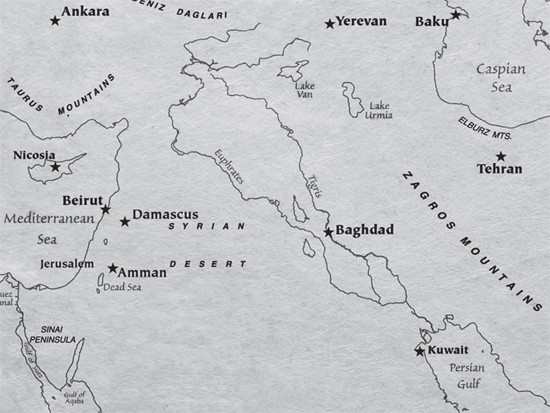The question of “Where Was The Garden Of Eden Located” has intrigued theologians, historians, and curious minds for centuries. Popular belief and many biblical interpretations point towards the Middle East, specifically near the Tigris and Euphrates rivers. This presumption is largely drawn from the descriptions in the Book of Genesis. However, a closer examination of scripture and geological realities challenges this traditional view, suggesting the true location of Eden remains shrouded in mystery.
The Traditional View and Biblical Texts
Genesis 2:8-14 provides the primary scriptural basis for placing Eden in the Middle East. The passage describes God planting a garden “eastward in Eden” and details a river flowing from Eden that divides into four headwaters: the Pishon, Gihon, Hiddekel (identified as the Tigris), and Euphrates.
The Lord God planted a garden eastward in Eden. . . . Now a river went out of Eden to water the garden, and from there it parted and became four riverheads. The name of the first is Pishon . . . . The name of the second river is Gihon. . . . The name of the third river is Hiddekel [Tigris]. . . The fourth river is the Euphrates.
This description has led many to pinpoint the Garden of Eden in Mesopotamia, the land between the Tigris and Euphrates rivers in modern-day Iraq. The familiarity of the Tigris and Euphrates names in this region reinforces this geographical assumption for many.
John Calvin’s Perspective on Eden’s Rivers
Even prominent theologians like John Calvin grappled with the geographical puzzle presented by the Genesis account. In his commentary on Genesis, Calvin acknowledged the common agreement on the Tigris and Euphrates rivers but expressed considerable difficulty with the other two rivers, Pishon and Gihon, and the overall river system described.
Calvin noted the suggestions that Pishon and Gihon might correspond to the Ganges and Nile rivers, respectively. However, he astutely refuted this idea due to the vast distances involved, deeming it geographically improbable that the Garden of Eden could encompass such a wide area from Asia to Europe. He recognized the description of a single river diverging into four heads problematic when considering the geographically distant sources of the modern Tigris and Euphrates.
The Challenge of Modern Geography and Noah’s Flood
Calvin himself hinted at a crucial point when considering the difficulty in reconciling the Genesis description with the known geography: the earth’s surface may have been drastically altered by a major deluge. This consideration becomes paramount when understanding why the present-day Middle East may not align with the original description of Eden.
The biblical account of Noah’s Flood describes a global catastrophe that reshaped the entire earth. Creationist geologists argue that the vast sedimentary layers found across the globe, often thousands of feet thick and containing abundant fossils, are primarily a result of this cataclysmic Flood. If this is the case, the pre-Flood geography, including the original location of the Garden of Eden and its river system, would have been utterly transformed.
Noah’s Flood and a Catastrophic Earth
The implications of Noah’s Flood are profound when considering the location of Eden. The region where the Tigris and Euphrates rivers currently flow is underlain by substantial sedimentary strata, rich in fossils. These fossil-bearing layers are understood by creationists to be deposits from the Flood.
 Map
Map
Map of the Middle East showing the Tigris and Euphrates rivers, often associated with the presumed location of the Garden of Eden.
This geological reality presents a significant challenge to placing the Garden of Eden in the modern Middle East. The concept of a perfect, pristine Garden of Eden existing atop layers of Flood sediments containing billions of dead organisms (fossils, evidence of death) contradicts the biblical narrative of sin and death entering the world after the creation of Adam and Eve in the Garden. The existence of fossils beneath the Tigris and Euphrates region indicates a history of death before the potential placement of Eden there in the post-Flood world.
Renaming the Post-Flood World
If the pre-Flood world was destroyed and reshaped by Noah’s Flood, why do rivers with names like Tigris and Euphrates exist today? The answer likely lies in the practice of renaming places after familiar landmarks, a common human behavior seen throughout history.
Consider the example of European colonization. Settlers in Australia, for instance, named new settlements “Newcastle” after the English city. Similarly, the United States has rivers named Thames, Severn, and Trent, echoing prominent rivers in the United Kingdom. These examples illustrate the tendency to reuse familiar names when establishing new places.
It is plausible that Noah and his family, emerging from the Ark in the region of the mountains of Ararat (in the Middle East), used names from the pre-Flood world, such as Tigris and Euphrates, to name rivers in their new post-Flood environment. This act of renaming would have served as a connection to their lost world and a way to orient themselves in a drastically changed landscape.
Conclusion: The Mystery Remains
Ultimately, while the Bible provides clues, the precise location of the Garden of Eden remains unknown. Attributing its location to the area of the modern Tigris and Euphrates rivers overlooks the cataclysmic impact of Noah’s Flood and the geological evidence that contradicts such a placement.
The focus should shift from a definitive geographical location to understanding the theological significance of the Garden of Eden as a place of perfection and humanity’s original, sinless state. The mystery surrounding its location serves as a reminder of the transformative power of Noah’s Flood and the profound changes it wrought upon the earth, effectively separating us from the pre-Flood world, including the original Garden of Eden.

